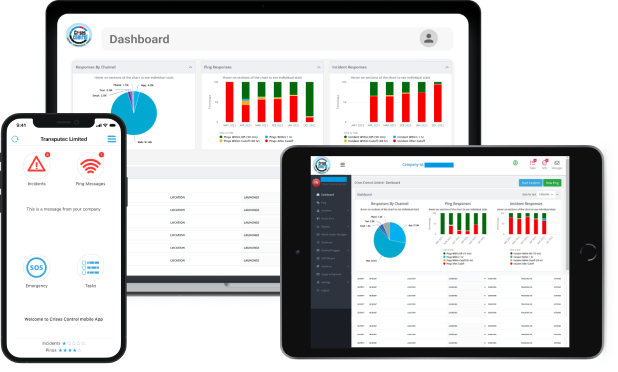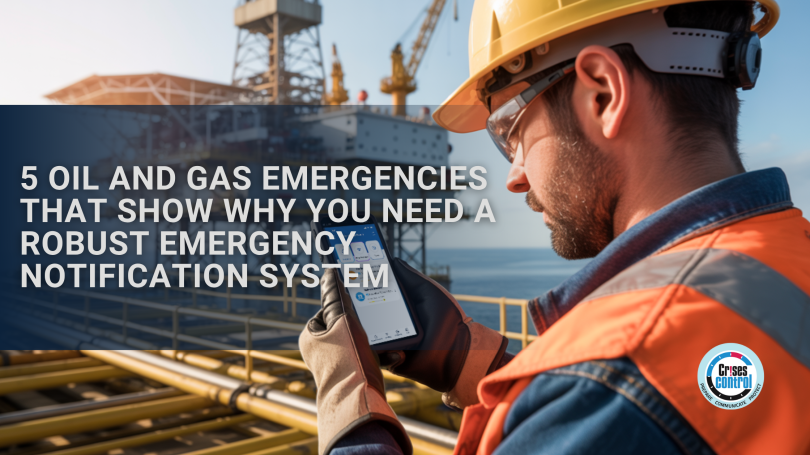Written by Anneri Fourie | Crises Control Executive
The oil and gas sector is one of the most complex and hazardous industries in the world. Whether you’re managing offshore rigs, refineries, pipelines or remote drilling operations, emergencies can strike at any moment. And when they do, how you respond in the first few minutes makes all the difference.
But here’s the problem: many organisations in this sector still rely on outdated, siloed communication tools that were never designed to handle large-scale, multi-site emergencies. Delays, missed alerts, confusion and lack of coordination are common. These gaps don’t just put lives at risk, they also cause environmental damage, loss of reputation and huge financial penalties.
A modern Emergency Notification System is no longer a nice-to-have. It’s a business-critical investment.
In this blog, we’ll walk through five realistic emergency scenarios and explain why a strong communication platform matters. We’ll also show how Crises Control, with its new Microsoft Teams integration, helps companies manage crises effectively and keep their people and operations safe.
Offshore Oil Spill: Time Lost Equals More Damage
An offshore drilling platform suffers a sudden mechanical failure. Crude oil begins leaking into the sea. Every minute counts when it comes to containment and environmental response. Yet instead of launching an oil spill alert system instantly, the company uses manual call trees and scattered email chains.
Two hours pass before the full response team is activated. By then, the oil has spread, cleanup costs have soared and regulators are asking difficult questions.
This kind of delay is avoidable. A fit-for-purpose Emergency Notification System for oil and gas operations should allow teams to trigger alerts in seconds, not hours. Crises Control provides automated workflows and multi-channel notifications that ensure your response teams are reached immediately via SMS, push notifications, voice calls, email and Microsoft Teams.
No need to waste time wondering who has received the message. Real-time dashboards confirm who has acknowledged the alert and who still needs to respond. And with pre-built templates, there’s no need to draft messages during a crisis.
Refinery Fire: Confusion in the Heat of the Moment
During routine maintenance at a large refinery, a fire breaks out in one of the units. There are contractors, engineers and vendors on-site. But because the organisation has no central system to manage communication during refinery fires, chaos breaks out. Some people evacuate. Others don’t hear the alarm. Conflicting instructions circulate.
This is exactly the kind of situation where clear, coordinated communication can save lives. Crises Control allows for emergency communications during refinery fires to be delivered in real time to everyone on site. Its two-way messaging also lets teams confirm their safety or report hazards as they evacuate.
The Microsoft Teams integration means crisis teams can coordinate live in the same space they use daily. This streamlines decision-making and ensures everyone is aligned, even if they’re working from different locations.
Having a clear digital trail of who received what, when, and how they responded also supports post-incident investigations and helps with compliance.
Pipeline Cyberattack: When SCADA Systems Go Dark
Cyber threats are a growing concern in the oil and gas sector. In this scenario, a cyberattack disables the SCADA system that controls a major pipeline. Suddenly, pressure controls are offline, monitoring is lost, and field engineers have no visibility. Panic starts to spread.
IT teams try to regain control, but without a functioning communication system in place, updates are slow and fragmented. Field staff don’t know what’s happening. Senior managers can’t make informed decisions.
Crises Control works even when your core IT systems are compromised. It provides a separate, resilient platform for incident management in oil and gas operations. Alerts can still be sent, escalation paths still function, and every action is logged for reporting and recovery.
Explosion at Remote Oil Field: Delayed Communication Puts Lives at Risk
In a remote oil field hours from the nearest emergency services, a sudden explosion disrupts operations. Field workers are scattered, communication is patchy, and head office is left in the dark. With no immediate visibility into who is safe, injured, or missing, precious time is lost.
This kind of event shows why two-way alerting for remote oil field staff is essential. While limited connectivity can pose challenges, Crises Control ensures that as long as there is basic internet access or mobile signal, critical alerts can still get through.
Through the platform, staff can check in with their status, request help, or confirm their location. Real-time dashboards allow safety managers to track who’s been accounted for and who still needs to respond.
The result is a faster, more coordinated response in areas where traditional communication tools may fall short. It’s not about eliminating the need for connectivity, but making the best possible use of whatever signal is available.
Natural Disaster Hits the Supply Chain
A severe storm hits a port that supplies essential drilling equipment. Roads are flooded, warehouses are damaged and delivery schedules are in disarray. Regional managers struggle to get updates and make quick decisions about rerouting and supply recovery.
Crises Control’s incident management software for oil and gas can map supply chain dependencies and trigger notifications to all affected parties instantly. Based on role, location or custom criteria, you can send targeted messages to field teams, logistics managers and suppliers.
Two-way communication means teams can send back updates from their end, providing a real-time picture of how the situation is unfolding.
What Makes a Notification System Fit for Oil and Gas?
Oil and gas environments have unique challenges. A good Emergency Notification System needs to be:
- Resilient: It should work even if your main IT systems are down.
- Flexible: It must support multiple communication channels, including Microsoft Teams.
- Smart: Automating escalation and role-based alerts avoids confusion.
- Global: The system should function across time zones, languages and regulatory boundaries.
- Accountable: Every message and action should be auditable.
- Reliable: It should have offline features for remote or unstable environments.
Crises Control is built with these requirements in mind. The platform helps global energy companies improve safety, speed up response times and reduce the impact of operational disruptions.
How Crises Control Bridges the Communication Gap
Many organisations still rely on fragmented tools: radios, spreadsheets, manual lists, or group emails. These are not designed for fast-moving, high-risk environments. Crises Control simplifies emergency communication with:
- Multi-channel delivery: Messages go out via SMS, email, voice calls, push notifications, web alerts and Microsoft Teams.
- Pre-configured templates: No need to draft alerts during a crisis.
- Live dashboards: Know who’s responded and what needs action.
- Two-way alerts: Staff can check in, report issues or request help.
- Audit trails: For compliance, analysis and training.
By embedding Microsoft Teams integration for emergency alerts, Crises Control lets teams collaborate using tools they’re already familiar with. This means quicker adoption, reduced training and smoother coordination.
Final Thoughts: Don’t Wait Until the Next Incident
The five scenarios outlined in this blog are all too real. Each one reflects the kind of high-stakes challenge oil and gas companies face regularly. In every case, having the right Emergency Notification System in place could have changed the outcome.
Whether it’s an oil spill, a cyberattack, a refinery fire or a remote safety incident, communication is the thread that holds your response together. Crises Control provides a smart, dependable and industry-specific solution that allows you to act faster, keep people safe and reduce the impact of disruption.
If you’re ready to close the communication gaps in your crisis response strategy, we can help.
Contact us today to book your free demo of Crises Control.
Request a FREE Demo

